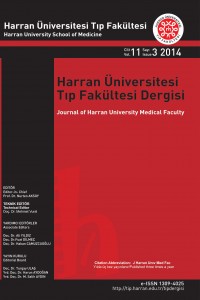Abstract
An eighteen-year-old female patient admitted to our clinic with complaints of shortness of breath and
palpitation. The patient's medical and family history was unremarkable. Twelve-lead electrocardigraphy
revealed incomplete right bundle branch block with sinus rhythm. Transthoracic echocardiography (TTE)
showed both ostium primum and secundum type atrial septal defect (ASD) with a slight dilatation of right
heart chambers (Figure 1A-1B). In addition, a mild-to-moderate mitral regurgitation with mitral valve
prolapsus (MVP) was detected which was thought to be secondary to ASD (Figure 1C). Transesophageal
echocardiographic (TEE) examination confirmed the prolapsus of anterior mitral valve leaflet and mild to
moderate mitral regurgitation, ostium secundum and ostium primum defects, 7.6 mm and 13.3 mm in size,
respectively (Figure 2A-2B). The systolic pulmonary artery pressure was 45 mm Hg, and there was a
significant shunt with a Qp / Qs ratio of 1,7. The patient underwent surgical intervention. Secundum ASD
was repaired with a pericardial patch and direct suture closure of primum ASD was performed. Postoperative
TTE revealed trace mitral regurgitation with an intact atrial septum (Figure 3). Here, we are reporting a rare
combination of ostium primum and secundum defects with mitral valve prolapsus.
References
- -
Abstract
An eighteen-year-old female patient admitted to our clinic with complaints of shortness of breath and
palpitation. The patient's medical and family history was unremarkable. Twelve-lead electrocardigraphy
revealed incomplete right bundle branch block with sinus rhythm. Transthoracic echocardiography (TTE)
showed both ostium primum and secundum type atrial septal defect (ASD) with a slight dilatation of right
heart chambers (Figure 1A-1B). In addition, a mild-to-moderate mitral regurgitation with mitral valve
prolapsus (MVP) was detected which was thought to be secondary to ASD (Figure 1C). Transesophageal
echocardiographic (TEE) examination confirmed the prolapsus of anterior mitral valve leaflet and mild to
moderate mitral regurgitation, ostium secundum and ostium primum defects, 7.6 mm and 13.3 mm in size,
respectively (Figure 2A-2B). The systolic pulmonary artery pressure was 45 mm Hg, and there was a
significant shunt with a Qp / Qs ratio of 1,7. The patient underwent surgical intervention. Secundum ASD
was repaired with a pericardial patch and direct suture closure of primum ASD was performed. Postoperative
TTE revealed trace mitral regurgitation with an intact atrial septum (Figure 3). Here, we are reporting a rare
combination of ostium primum and secundum defects with mitral valve prolapsus.
References
- -
Details
| Primary Language | English |
|---|---|
| Journal Section | Image Presentation |
| Authors | |
| Publication Date | December 15, 2014 |
| Submission Date | May 17, 2013 |
| Acceptance Date | June 21, 2013 |
| Published in Issue | Year 2014 Volume: 11 Issue: 3 |
Harran Üniversitesi Tıp Fakültesi Dergisi / Journal of Harran University Medical Faculty


